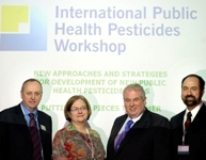The Chartered Institute of Environmental Health (CIEH) in London played host to over 100 international delegates from nearly 20 countries gathered together to discuss ways to increase the availability of public health products designed for worldwide vector (primarily malaria) control.
Over one million people die of malaria each year, or put another way, 320 people per day in Uganda. Yet this figure is set to rise if drastic action is not put in place to halt these fatal statistics. Over the three days of 19-21 May 2009, this unique gathering of senior regulators, producers, public health authorities, and users was drawn together charged with the objective to identify ways to increase the availability of public health pesticide products.
|
In her opening address at the International Public Health Worksop (IPHPW), Lois Rossi, director of the registration division of the US Environmental Protection Agency said: “Worldwide public health programmes are faced with a depleting arsenal of chemicals. Regulatory control has affectively limited the products available, yet diseases are spreading in both developed and developing countries. New initiatives, new funding and new innovations are required. Regulatory authorities around the world are faced with the same problems. Our objective is to promote dialogue between the stakeholders, identify steps forward and to leave the meeting with a strategy and a plan to execute it.” A tall order no less. Historically both pesticide manufacturers, and also regulators, have concentrated their efforts on pesticides destined for agricultural use. Public health uses have been treated as a spin-off from agriculture. International regulatory organisations, such as the EPA, have evaluated public health products on procedures designed primarily for agricultural products. Many WHO member countries have systems set-up to cover agricultural chemicals, yet have nothing in place for biocides. A startling revelation was that, to date, there has been no insecticide developed for public health which had not yet gone through the agricultural regulatory system first. From a manufacturer’s viewpoint, the low return on investment in developing an active ingredient solely for public health use was revealed in a market survey conducted by Dalberg Global Development Advisors from Switzerland, with funding from the Bill & Melinda Gates Foundation. They estimated it took a minimum of ten years and at a cost ranging from $60 – $200m to produce a product for sale in a market estimated to be worth only $750m in 2006. Yet all is not gloom. Vector control is now seen as a growing market – as a result the ingenuity of producers and regulators will find a way forward. This meeting itself being a prime example of the growing commitment. Speakers from several of the leading NGOs represented who are more frequently associated with agricultural matters announced the appointment of vector-specific sections – these included CropLife International and also the Inter-Regional-4 Project in the USA. The US EPA is also developing a biocides-specific branch However, one need look no further than the Innovative Vector Control Consortium (IVCC) to see what a step-change increased commitment and most importantly, substantial funding, can make. To date, nearly $51m has been awarded to IVCC by the Bill & Melinda Gates Foundation. |
|






